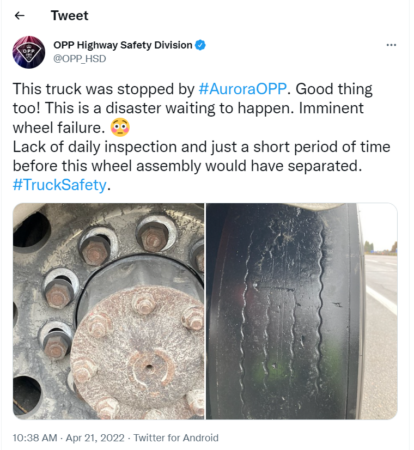Roadcheck’s wheel focus is as timely as ever
Ontario Provincial Police (OPP) referred to it as a disaster waiting to happen.
Even the uninitiated could see something wrong with the wheel held in place by little more than gravitational forces. Loose studs hang at the edges of their respective holes. Moving washers have carved their paths into the wheel face. The tire in a corresponding image is so worn that it could pass for a racing slick, or maybe a buffed casing.
“Imminent wheel failure,” the OPP Highway Safety Division declared in a Tweet that featured the photos. “Lack of daily inspection and just a short period of time before this wheel assembly would have separated.”

This equipment had no place on an active roadway. Not this day. Not during the many days leading up to the moment when it was finally taken out of service.
But the images reinforce the need for a special focus on wheels that will occur May 17-19 during the 2022 International Roadcheck inspection blitz.
“Wheel end components support the heavy loads carried by commercial motor vehicles, maintain stability and control, and are critical for braking,” the Commercial Vehicle Safety Alliance (CVSA) said, when announcing the special focus for this year’s blitz. “Violations involving wheel end components historically account for about one quarter of the vehicle out-of-service violations discovered during international Roadcheck, and past International Roadcheck data routinely identified wheel end components as a Top 10 vehicle violation.”
Such issues are particularly disturbing because wheel losses are often catastrophic. That point was reinforced during an Ontario coroner’s inquest into the deaths of Angela Worona and James Tyrrell, both killed by runaway wheels in 1995. What emerged included the Commercial Vehicle Wheel Service training program for wheel installers, and some of North America’s steepest penalties for such losses.
As far as we’ve come, though, there are still gains that need to be made. Ontario alone reported 2,327 wheel separations between 1997 and 2019.
While much has been learned, more attention is clearly required.
Only the click of a torque wrench will ensure proper clamping forces, while a blast from an impact wrench can stretch the studs. Contact surfaces need to be clean of dirt and rust to ensure dual wheel assemblies fit snugly together. Anything beyond 3-3.5 mils of paint can wear away and create gaps between the all-important mating surfaces.
A poorly tightened bearing can cause a wheel to wobble and damage the seal, leaving the protective lubricant to spill onto the road. Too much tightening can cause an issue of its own, leading to the excessive preload that causes bearings to overheat and the seals to fail.
Then there’s the need to check fastener torques 80-160 km after wheels are installed. That isn’t always practical, but some fleets are taking added steps such as checking the torque after a series of tight turns and hard braking around the fleet yard.
Finally, it is up to truck drivers to watch for the telltale signs of impending failures – the missing or damaged fasteners, the rust streaking from bolt holes, cracked wheels, and leaking hubs.
Each of those issues can be spotted during a proper circle check. Just like the type of circle check that would have spotted the issues with a wheel before it became fodder for a tweet by the OPP.
Have your say
This is a moderated forum. Comments will no longer be published unless they are accompanied by a first and last name and a verifiable email address. (Today's Trucking will not publish or share the email address.) Profane language and content deemed to be libelous, racist, or threatening in nature will not be published under any circumstances.
Only way to stay far from these issues, is to operate a solid wheel program in your fleet … a minimum investment for potentials heavy cost’s, ruined reputation, downtime with significant impact’s no ones need !
Wheel off-on procedures, appropriate tooling, components you can rely on, audit your program (keep it alive ! )